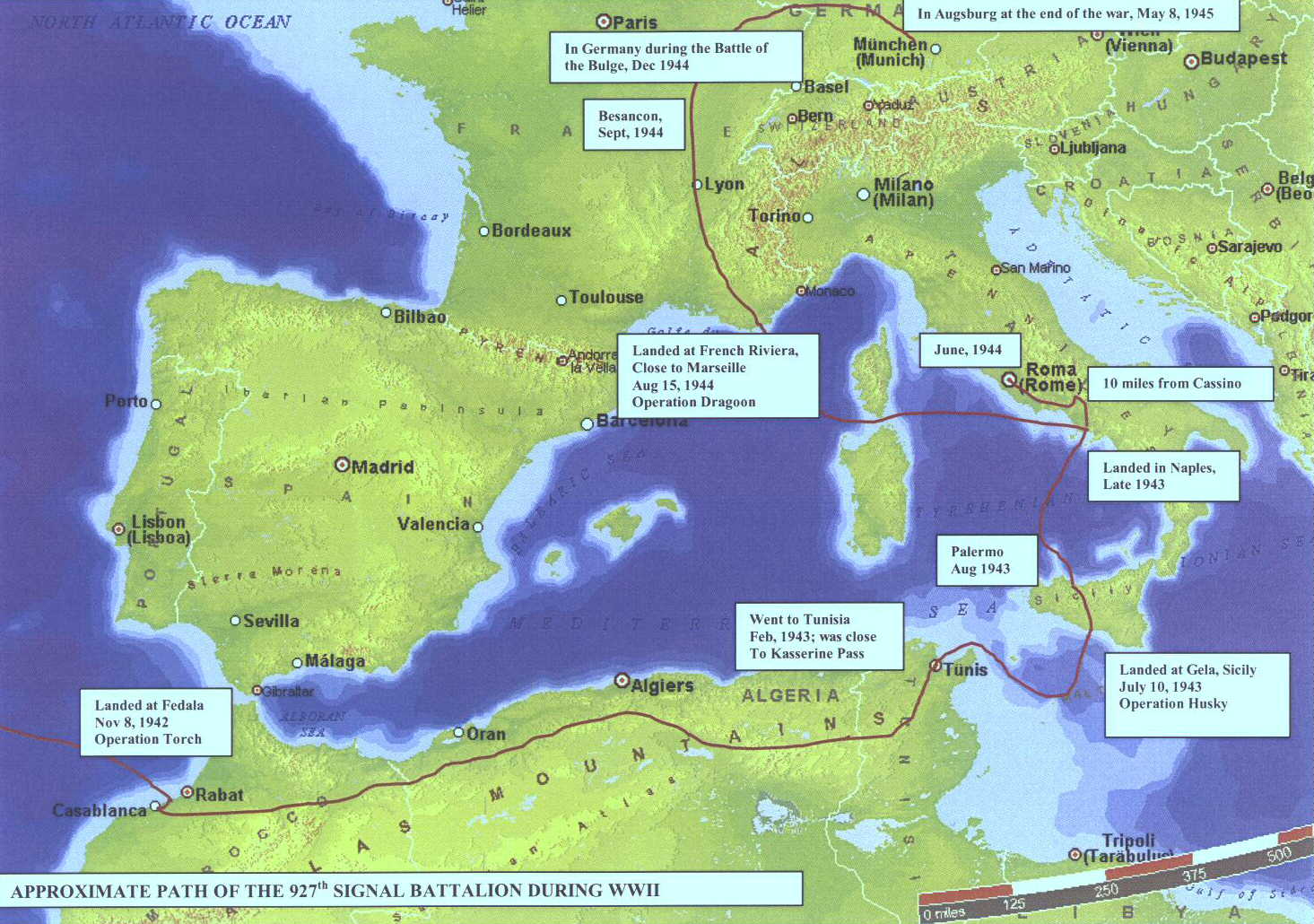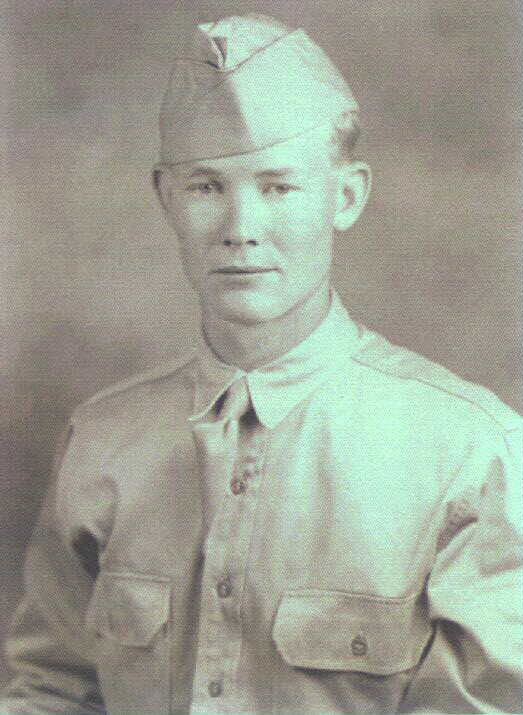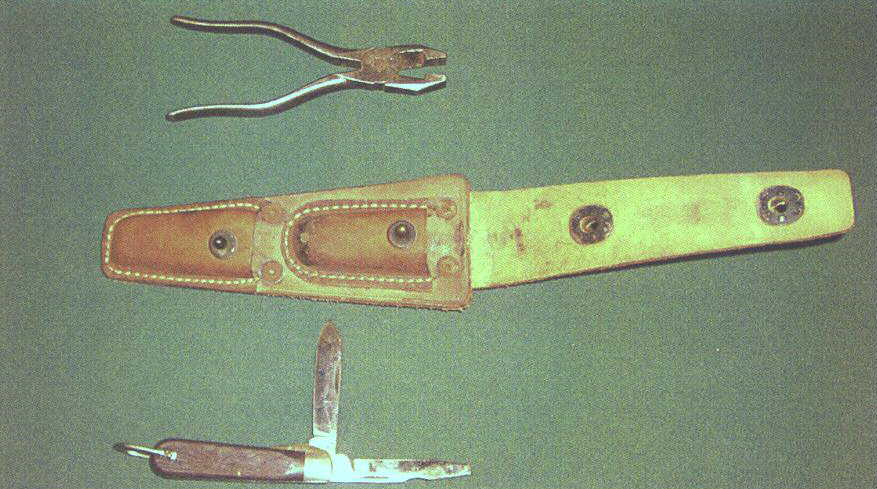|
WELCOME TO
|
||
A Brief History of the Path
Taken by the 927th Signal Battalion In World War II
By Dale Skelton September 20, 2003
In memory of James E. "Red" Skelton, Jr. And Norman "Chink" Pockrus
With special acknowledgement and honor to W. A. "Bill" Ringener
Ruby and James E. Skelton, Jr.
- July 18, 1954
(click photos to enlarge)
| For many years my brother, sister and I have
often wondered where our Dad, James Estel Skelton Jr., was during World War II; what
campaigns was he involved in, what areas of Europe was he located in, and was he in any of
the more well-known battles that you read about or see documented on television? All we
knew was that he was in the Signal Corps and that he had been in Africa, Sicily, Italy,
France and Germany. This curiosity became even stronger for me when I had the opportunity
to fly to Germany last spring on business. When I landed in Frankfurt and took a
connecting flight to Munich, and as I rode in the taxi to Freising, I could not help but
wonder if Dad had been in this area during the war (as it turned out, I was approximately
60 miles from where he was at the end of the war). After the trip to Germany, I went to
Midland to visit my mother, and found Dad’s box of keepsakes from his school days at
Westbrook. Also included in the box were his keepsakes from the war; pictures of army
buddies, post cards from towns that he had been at, V-mail that he had sent to relatives,
and some memos about his commendations. Also in the box was a scrapbook kept by his mother
that contained newspaper clippings, important dates, and some letters that he had written
to them. From the information in this box, I knew that he had been assigned to the 927th
Signal Battalion; he had a campaign medal with 9 battle stars for each campaign that he
was involved in, he received a Bronze Arrowhead for participating in an amphibious assault
in Southern France, and he received a good conduct medal.
The campaigns he was in were: |
||
|
Algeria - French Morocco
|
||
| I also learned that he was inducted into the Army on April 14, 1942 in Lubbock, as an enlisted man, at the age of 19 (1 month shy from 20). He was then sent to Fort Sill, Ok, where he was to receive an assignment. While in Fort Sill, he sent the following letter to his parents: | ||
|
Fort Sill, Okla
|
||
| Dear Folks,
I shipped my clothes home yesterday C.O.D.
|
||
| He was then assigned to the 927th Signal
Battalion, and sent to Will Rogers Field, Oklahoma City, on April 18 for training. He was
being trained to set up communications lines between the Army ground forces and the Army
Air Force as the front would be advancing. James was promoted to Corporal on June 20,
1942. According to newspaper clippings in grandma’s scrapbook, his Signal Battalion
participated in “war games” that were held “somewhere in Louisiana”
beginning August 1. A piece of an envelope in the scrapbook with a postmark date of Aug 4,
1942, Mansfield, LA hints at where the location was. One newspaper clipping stated,
“Co-ordination of air and ground forces is one of the prime objects of the
training”. There is one newspaper clipping with a story about “Signal Battalion
Scores High On Maneuvers Despite Hungry Cows”. Apparently the cows chewed up 3 miles
of communications wiring. During the maneuvers, “450 men strung up over 300 miles of
communications wires and utilized 4500 stakes and 2500 poles to do it”. The maneuvers
lasted for about 6 weeks.
He then went back to Will Rogers Field, expecting to go back home on a furlough that was to begin on October 1st. Grandma saved a Western Union Telegram that Dad had sent on Sept 29: |
||
|
Oklahoma City,
Okla 9/29/42
|
||
| Furlough starts October 2nd instead of 1st. Son
James Skelton |
||
| All of his sisters and relatives were planning to come to Westbrook to see him one last time before he went overseas; they were planning a big celebration, but the celebration never took place. Dad’s furlough got canceled at the last minute. Here’s a letter that he sent to his parents after telling them on the phone that the furlough was canceled: | ||
|
Will Rogers Field
|
||
| Dear Folks,
I just finished phoning to you all. I sure was disappointed not to get the furlough. I don’t know what is taking place but I have an idea. Well I said all I knew when I called and we are going to work so will stop. The work is over so I will continue to write. I don’t know exactly how I felt when I called you all, but I guess you all knew. Well, I will stop. |
||
|
Your
son,
|
||
| After hearing that their son’s furlough
was canceled, his Mom and Dad drove to Will Rogers Field to see him before he left for the
war. Three years would pass before they would see him again.
In Dad’s box of keepsakes, he had pictures of the following buddies:
Mom had told me that Dad had been a close friend with Bill after the war, and that Bill lived in Stanton, so I decided to call him last July. Bill was very willing to answer my questions about where they were located during the war. He said that they were attached to the 12th Air Support Command (was later renamed 12th Tactical Air Command), and were assigned to different infantry divisions during the campaigns to establish the ground - to - air communications lines. The infantry divisions included the 3rd (Rock of the Marne), 36th (Texas T-patchers) and 45th (Rock of Anzio). Their jobs required them to be in the initial landings during amphibious assaults to set up communications before a Command Post (CP) could be established, and to be on the front lines or close to the front as the front advanced. Sometimes they would find themselves ahead of the front when the front was advancing at a fast rate. I sent him a letter of additional questions, and he was very helpful and responsive in answering those questions. He told me that he met Dad at Fort Sill; Dad looked like he had lost his last friend, so Bill struck up a conversation, and they realized that they had grown up in the same part of West Texas. Bill lived in Loraine until his freshman year, when his family moved to Big Springs. Loraine is about 20 miles east of Westbrook. Bill had just been married on Jan 6, 1942, when Uncle Sam called him into the service on April 9. Bill was 21 years old. Dad was called “Red” during the war. Bill and Red left Will Rogers Field and went to Langley Field, VA, to get ready to go overseas. They left Langley Field on Oct 23 on the USS Stanton, and headed for North Africa. Bill and Red were assigned to Signal Company B at the beginning of the war. Bill was a Technician 3rd grade (T/3), Dad was a Technician 5th grade (T/5). |
||
Newspaper clipping from
Grandma's scrapbook, which Dad had sent her.
The 927th Signal Battalion had marched in a July 4th, 1942 parade in
downtown Oklahoma City. Dad and Bill were in Company B
(click to enlarge)
The following is an attempt to trace the path that Dad took during WWII, based on information from Mr. Ringener, and on research about the divisions that they worked with through the war.
|
|
(click to
enlarge)
|
|
|
|
|
|
|
|
|
|
|||
|
Last Updated: |
|||
|
Copyright© 2007-Palmer - -The TXGenWeb Project - All Rights Reserved
COPYRIGHT NOTICE: All files on this site are
copyrighted by their creator. They may be linked to but may not be reproduced
electronically or otherwise without specific permission from the county host
and/or the contributor. Although public information is not copyrightable, the
format in which it is presented, the notes and comments, etc., are. It is
however, quite permissible to print or save the files to a personal computer for
personal use only.
|










